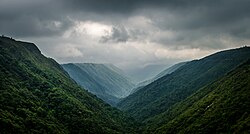Khasi Hills
Khasi Hills | |
|---|---|
Region | |
 Eastern Khasi Hills | |
| Country | |
| State | Meghalaya |
| Area | |
| • Total | 10,443 km2 (4,032 sq mi) |
| Population (2011) | |
| • Total | 1,468,223 |
| • Density | 140/km2 (360/sq mi) |
| Languages | |
| • Spoken | |
| Districts |
|
The Khasi Hills (
The Khasi Hills, and the entire Meghalaya state, was administratively part of Assam before 1970. In older sources in particular, the alternative transcription Khasia Hills is seen.[1]
The region is inhabited mainly by tribal
The region came under the Khasi Hills district, which was divided into the
The highest peak is Lum Shyllong which is 1,968 metres (6,457 ft) high.[4] It is situated a few kilometers south of Shillong town.[5]
Administration
Administratively, the Khasi Hills used to be a part of the Khasi Hills district.
Demographics
The population of the region according to the 2011 Census is 1,468,223.
Religion
Religion in Khasi Hills (2011)[8]
A vast majority of 1,128,769 people in Khasi Hills follow
Language
See also
References
- ISBN 8170353017.
- ^ Bhaumik, Subir (28 April 2003). "World's wettest area dries up" (stm). South Asia News. Calcutta: BBC. Retrieved 21 February 2008.
- ^ Bhattacharjya, Umasaday (1980). Local government in Khasi Hills. Vivek, 1980. p. 263.
- ISBN 978-0857451040.
- ISBN 3110122081.
- ISBN 978-8180696671.
- ^ "East Khasi hills". Government of India. Retrieved 15 August 2012.
- ^ a b "Population by religion community – 2011". Census of India, 2011. The Registrar General & Census Commissioner, India. Archived from the original on 25 August 2015.
- ^ ORGI. "C-16: Population by Mother Tongue". www.censusindia.gov.in. Office of the Registrar General & Census Commissioner, India. Archived from the original on 15 August 2018. Retrieved 10 July 2018.
- ^ DDW-C16-STMT-MDDS-0000.xlsx
Further reading
- Yule, Henry (1844). "Notes on the Khasia Hills, and people". Journal of the Asiatic Society of Bengal. 14 Part 2, Jul–Dec (152): 612–631.
